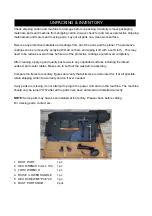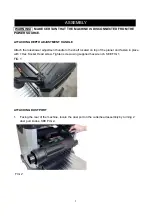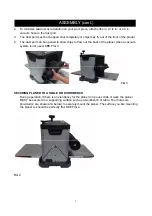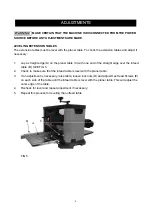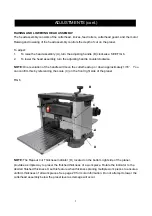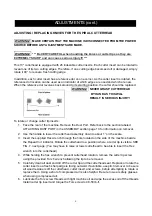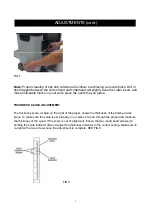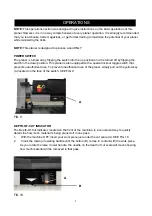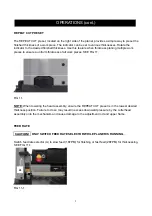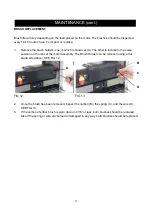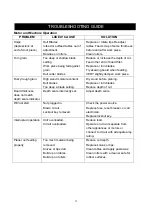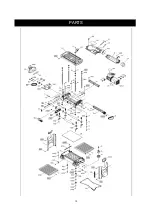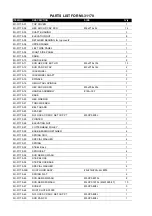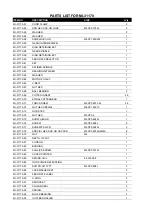
10
OPERATIONS (cont.)
GETTING PREPARED
It is always a good idea to use a piece of scrap wood for your first planing attempt. Also, before each
use of the planer, make it a habit of checking for loose fasteners, fittings or hardware. Turn the planer
ON and allow it to reach full speed. Pay close attention to any excessively loud noises that may be
coming from the planer or any excessive vibration. If either occurs, shut down the planer immediately
checking again for loose hardware. Go through the ASSEMBLY and ADJUSTMENTS sections again
if necessary.
BASIC OPERATION
WARNING!
To avoid serious personal injury, NEVER stand directly in line with the front or rear of
the planer. If an object is thrown from the planer, it will travel in this direction.
1. Stand to either the left or right side of the planer.
2. Flip the switch to the ON position.
3. Lift the work piece onto the infeed table by grabbing the edges of the board at the middle of
the length. NOTE: For longer pieces, be sure to use additional supports or stands.
4. Push slightly on the board to start feed and allow the feed rollers to pull the board through
the planer. Once the feed rollers start to pull the work piece through, let go of the board and
allow the rollers to do their job. DO NOT push or pull on the work piece once the rollers have
engaged.
5. Move to one side of the rear of the planer and receive the planed work piece by grabbing the
edges of the wood like you did when feeding the work piece in.
6. It normally takes several passes of varying depths to achieve a smooth finish, so repeat this
process as many times as necessary. Remember the less you take off in a pass, the
smoother the finish will be, but you may still need to finish the surface by sanding.
THICKNESS PLANING
Thickness planing sizes the work piece to a desired thickness, while at the same time creating a
smooth and level surface. The thickness of each cut will depend on the type of wood, width of the
work piece, and condition of the lumber (i.e. dryness, grain composition, straightness, etc). Always
make thin test cuts on a scrap piece of wood prior to performing final cuts.
GENERAL TIPS AND GUIDELINES
1.
Thickness planing always works best when at least one side of the work piece has a flat
surface. If both sides of the work piece are rough, feed one face of the board through the planer
until the entire surface is flat.
2.
ALWAYS plane both sides of the work piece to reach the desired thickness.
3.
DO NOT plane work pieces less than 1/8” thick, less than 3/4-in wide, or shorter than 7-in.
4.
It is not recommended to continuously use the planer at its maximum depth of cut (1/16”) and at
its full width (13”) as this will shorten the life of the motor.
5.
Light cuts create a smoother finish than heavier cuts.
6.
If a smooth cut is not obtained, see TROUBLESHOOTING GUIDE on page 24.
Содержание MI-31170
Страница 1: ...MODEL NO OPERATING MANUAL MI 31170 ...
Страница 15: ...14 PARTS 97 ...


